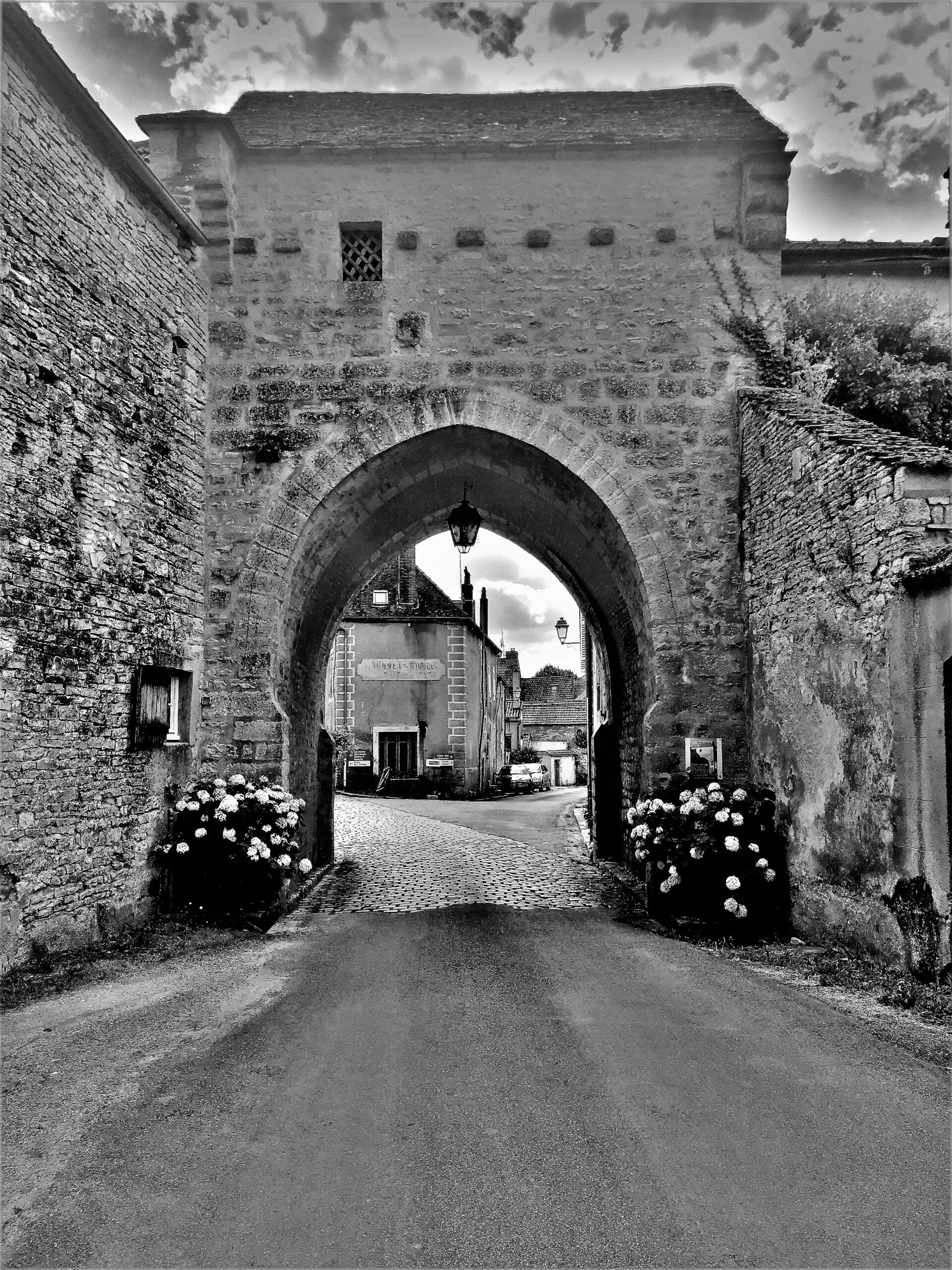Noyers, also called Noyers-sur-Serein, is a charmingly small medieval village located in the Burgundian countryside. Classified as one of The Most Beautiful Villages of France, Noyers is sure to transport you back in time!
Ideal for a day walking about or a visit to the local artisans, Noyers is the perfect day trip!
History of Noyers
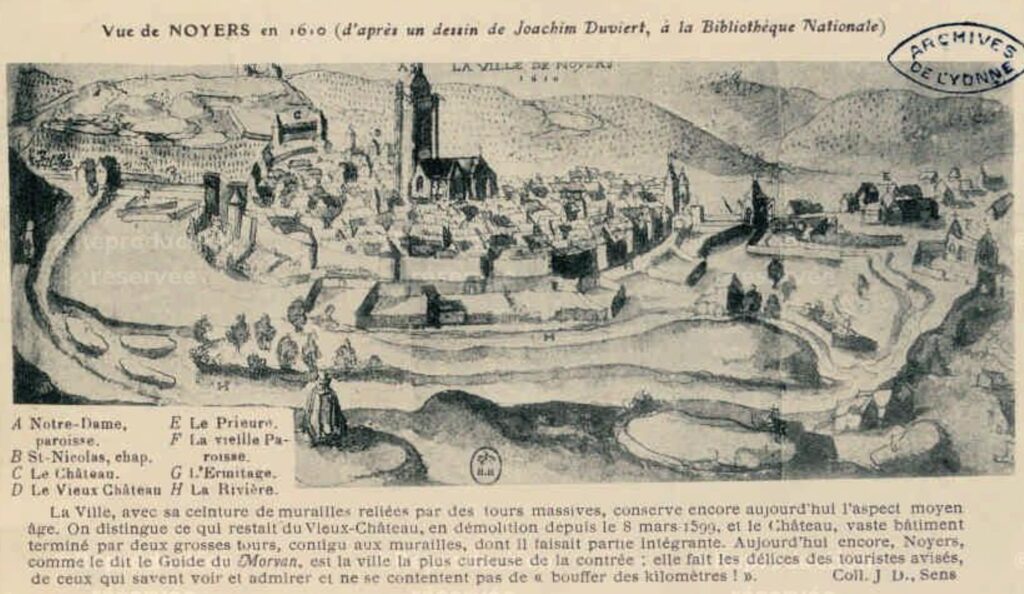
Postcard with drawing of Noyers in 1610 by Joachim Duviert
Origins of the village are not very clear, but are traced back to either founding by the king of the Sequane people or by a contemporary of Julius Caesar named Lucidorius. One thing is sure, though, Noyers gets its name from the “noyer” or walnut trees located in the area!
From the 12th century onwards, the village became the seat of the powerful seigneury of Miles de Noyers. Unfortunately, like all things, the seigneury came to an end. Without any heirs, it was sold to the Duchess of Burgundy in 1419.
After a long period of decline, the city was reborn under the Duke of Luynes who, in 1710, married the last descendant of the Condé family (Dukes of Burgundy).
Horticulture in Noyers
Noyers was once an important merchant village. Wine and grain trades flourished. Many documents note the importance of walnut and cherry trees as well as vineyards located on the surrounding hills.
Even today, farmers still have their place, although artisans and retirees replaced much of the agriculturalists.
Crafts in Noyers
Until the 20th century, local craftspeople included shoemakers, blacksmiths, cartwrights, hoop makers and coopers (for barrels). Nowadays, artisans in Noyers comprise of painters, potters, carpetmakers, leather crafters, and even a manuscript illuminator!
Why Should You Visit?
Noyers offers the rare picture of a preserved medieval village. With nearly 80 listed buildings dating from the 15th to the 19th centuries, many are remarkable 15th and 16th century half-timbered houses. One such house is the “maison du compagnonnage” (house of companionship) with its sculpted capitals dating to the 15th century. Representing Saint Crépin patron of the shoemakers or Saint Crépinien patron of the bakers, these sculptures are so small and cute!
Maison de la Toison d’Or (House of the Golden Fleece)
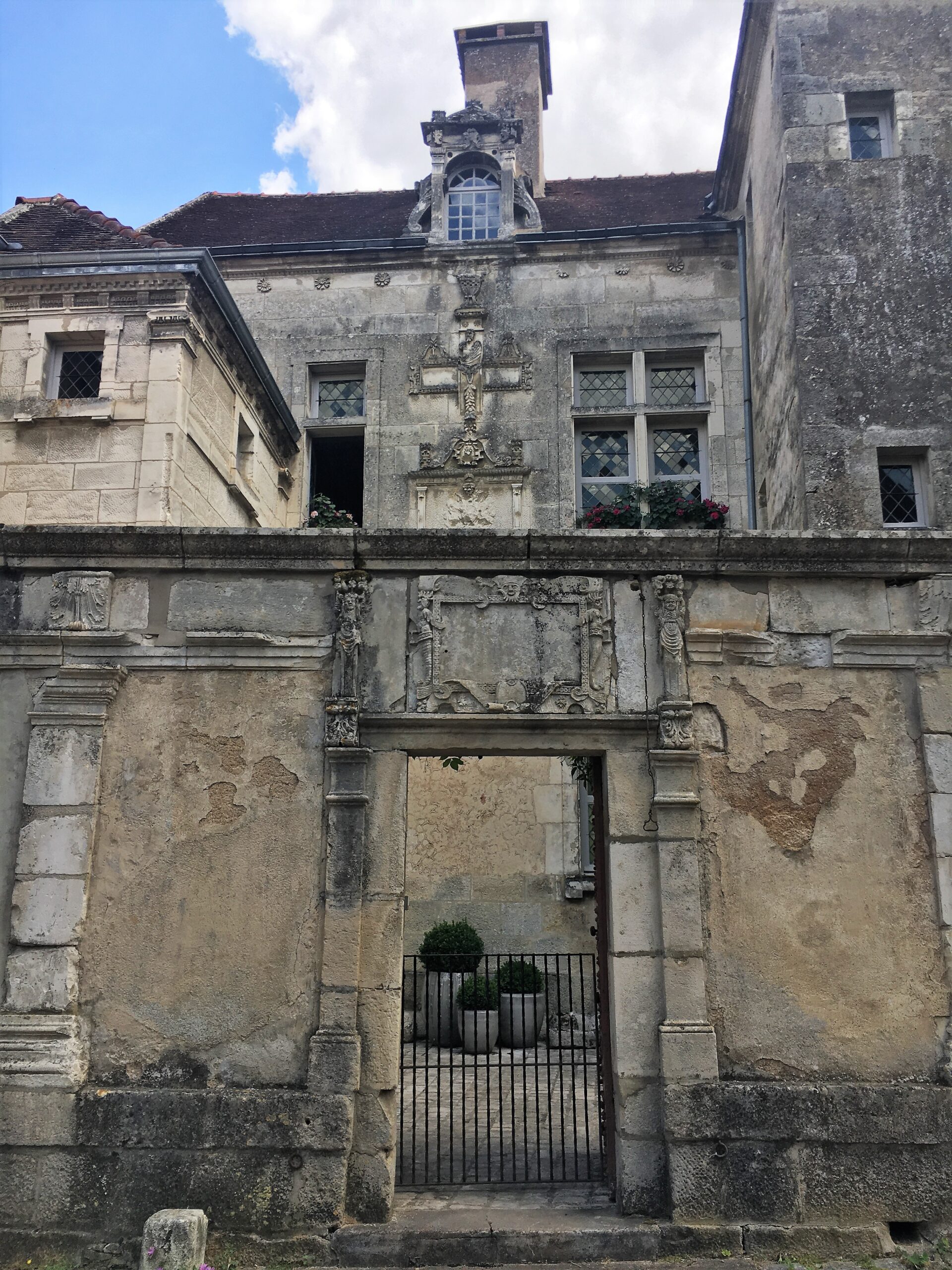
This is one of the first houses that caught my eye upon entering Noyers. It is a gorgeous noble house from the 15th century by Philippe Pot, minister of Philippe le Bon, Duke of Burgundy. Apparently, the Duke created the Order of the Golden Fleece and stayed in the home in 1433, possibly lending to its name. The façade visible today is of a Renaissance style with absolutely fascinating stone carvings.
Le Kamato
Another gem of 15th century architecture is the Kamato. Translating to “by suffering” from Greek, this was the house of justice and residence of the lordly bailiff. According to tradition, it would have housed pilgrims on their way to Santiago de Compostela.
Hôtel-Dieu Saint-Nicolas (Poorhouse of Saint-Nicolas)

Whilst walking around the village, I saw this particular building, the ancient hospice of Saint Nicholas. Founded in 1650 by Pierre de Selles, lord of Clavisy and resident priest at Noyers, this large building is now a hotel.
While returning home from hosting mass in a nearby village whose inhabitants could not come to Noyers due to flooding, de Selles nearly died when he fell under his horse in the overflowing river. Attributing his survival to the grace of God, de Selles decided to found the Hôtel-Dieu (poorhouse) of Saint Nicolas. Along with paying for its construction, de Selles also offered an annuity of 385 livres used to feed 6 poor persons as well as the person in charge of their care. Unfortunately, by 1750 the buildings had deteriorated to such an extent that they were almost uninhabitable.
After nearly 30 years of dispute, disuse and deterioration, the hospital of the faubourg joined the Hôtel-Dieu on December 20, 1782. This civil hospice thus functioned for 80 years.
By 1855, the Hôtel-Dieu closed its doors. Four years later, a Parisian notary purchased it. As before, the buildings eventually fell into ruin to be sold and renovated. The building now houses a hotel open to this day.
L’Ancien Collège (The Former College)

Founded in 1633 by the Christian Doctrine Fathers, this building has a striking sundial decorating its side. Accompanying it, a motto written in Latin evokes the passage of time.
Quis melior vitae monitor rerumque Magister Cum doceat rapido quo fugit hora pede itque redit que viam constans quam suspicis umbra Umbra fugax hommines non reditura susmus
The text translates to: “What better guide of our life that teaches us better the things of here below than the hour by the only fast step of which it flees. You have only one to fear: It comes and goes along your way, the shadow you dread. We are only a fleeting shadow that will not return.”
Les Tours et Remparts (The Towers and Ramparts)

The fortifications surrounding the city date back to the 13th century. Surprisingly, 19 of its 23 original towers are still visible or intact to this day.
You can book a guided tour of the fortified enclosure, weapons room and collection of armor, all to be led by a costumed guide.
If that is not your thing, I suggest walking the whole way around the ramparts for a picturesque and leisurely stroll where you can peep all 19 of the towers.
La Porte de Tonnerre
Part of the ramparts, the “Porte de Tonnerre” (thunder gate) is a gorgeous vestige of yesteryear. An important toll gate protected by multiple canons, this entry into the village also hides an interesting tradition.
Located in a niche facing the village is a 15th century polychrome statue of Notre Dame de la Voie de Passy (Our Lady of the Path of Passy). Nicknamed Sainte Vérote, she is decorated with vines of green grapes (called vérots) every 15th August. This tradition protects the grape vines from summer storms.
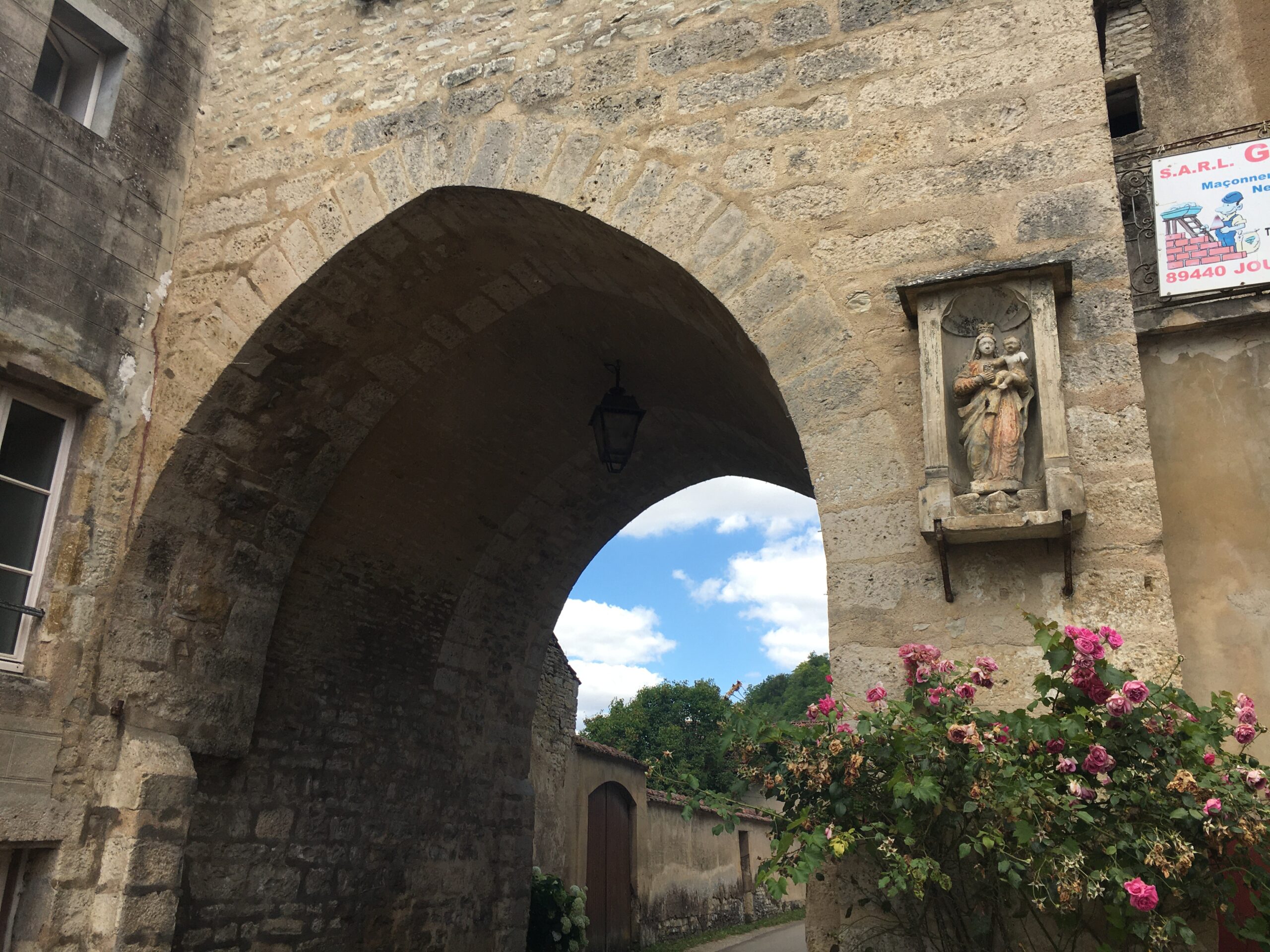
Vieux Château (Old Castle)
Another piece of history you can visit that is located just a bit outside of the village walls are the old castle ruins. Clerembaud de Noyers began its construction in 1190 before departing in crusade. Unfinished, the castle’s primitive foundations underwent a radical transformation by Hugues de Noyers at the end of the 12th century. As well, he also built the ramparts surrounding the village.
Museums
If you are not so much into looking at the architecture, you can always visit one of Noyer’s many museums.
Le Musée des Arts Naïfs et Populaires de Noyers is the number one museum in the department focusing on naïve and popular arts. The Maison du Schematisme is a fascinating museum dedicated to the avant-garde art movement of the 1960s of the same name.
La Serpentine
A nature walk amongst the ruins of the old château? You betcha! Guided by George, the guardian of Saint-Georges Mountain, you will discover the history of the old château. Composed of 12 informational panels, this historic walk takes about an hour to complete.
How English Friendly is it?
As I always say, you don’t need to speak French to appreciate art and architecture, your surroundings will speak for themselves! However, if you are looking for an English-friendly visit, this is somewhat a good choice.
Although the website and, it appears, most of their information booklets, plaques are for the most part in French, you can take a guided tour of the village in English. For this, you must call in advance to request one. Tours generally last 1.5 to 2 hours and prices are listed at 6.50€ per person.
Call at : 03 86 82 66 06
Unfortunately, I cannot speak about the quality of the guided tour, neither in French or English. When we showed up at the tourist office, although the website stated tours were held on that day, the kind woman told us that was not the case. Therefore, we went about touring the village ourselves.
Tips and Other Events
My tip is to call in advance if you want to take a guided tour. Also, make a stop at the tourism office for a free guidebook!
Le Gargouillosium
If you like gargoyles and stone carving, take a trip to Noyers during the 3-day event called “Le Gargouillosium”. During this period, 20 stone carvers unite at the site of the old château in order to amaze spectators and raise profits for charity.
All works are sold to profit the stonemasons as well as the charitable organization, Le Patrimoine Oublié – Association du Vieux Château de Noyers, which focuses on the restoration of the château.
Check the agenda for their next event.
Stone Carving Course
You can get your hands dirty as well! Think about signing up for a half-day’s introduction to stone cutting or decorative stone carving. The cost is 30€ per person (which is actually quite reasonable!)
If you choose to do the stone cutting course, the facing stones that you make will be used in the restoration of parts of the château. How cool!
For reservations, please call/email: 09 80 91 98 48 or contact@lepatrimoineoublie.fr
La Fête du Château
Taking place in August, this celebration honoring the château is a don’t-miss opportunity. A concert, lots of food and other surprises await you, just don’t forget to sign up!
Le Marché de la Truffe de Bourgogne (Burgundian Truffle Market)
The Sunday following Halloween (aka Toussaint) and the last Sunday of November are the days to come to Noyers if you are interested in truffles. Not just any truffles, these “black diamonds” are cultivated in Burgundy and attract quite a crowd! Information about the market is found here.
For other information, contact the Tourism Office of Noyers.
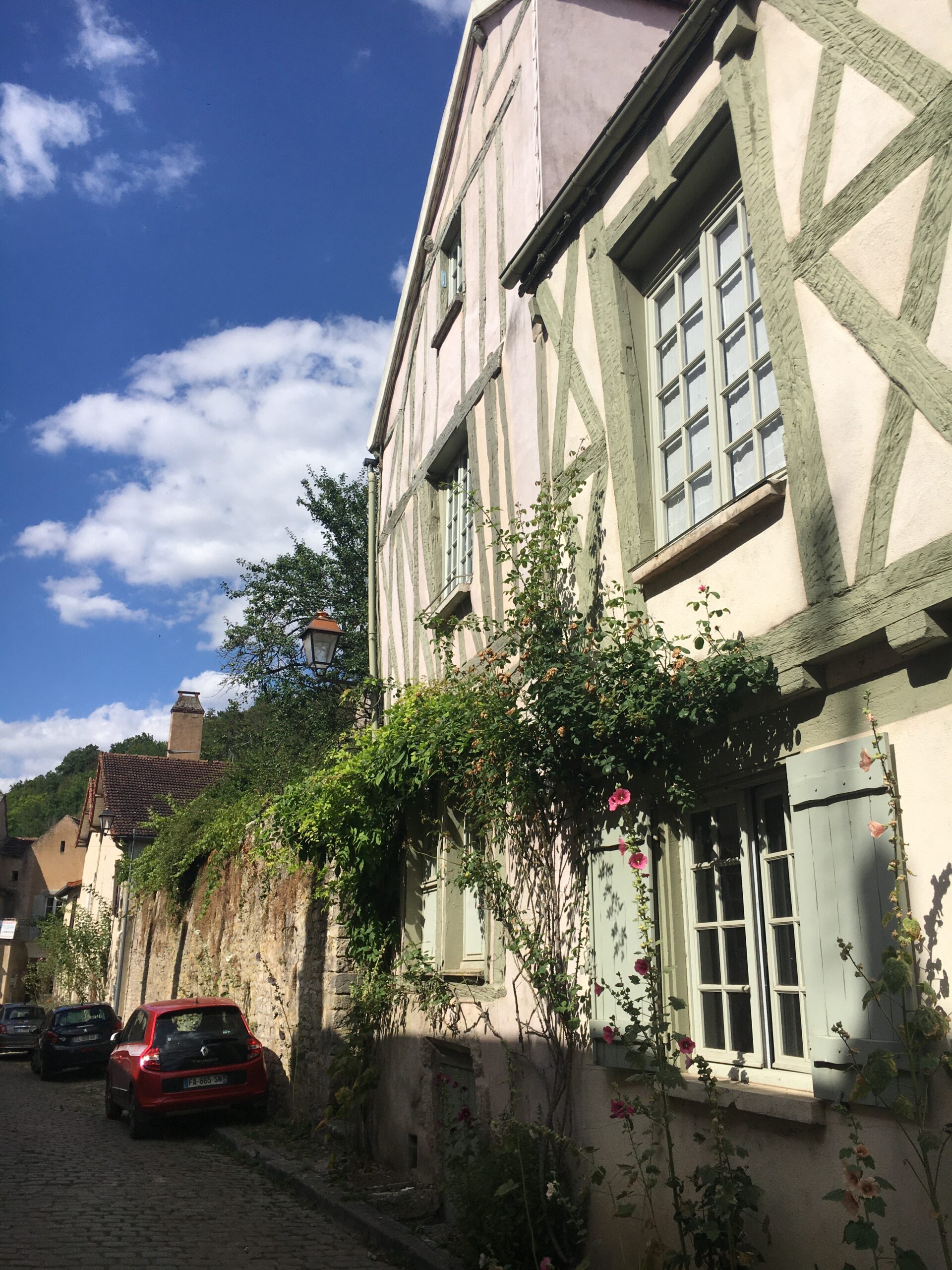
Read More:

